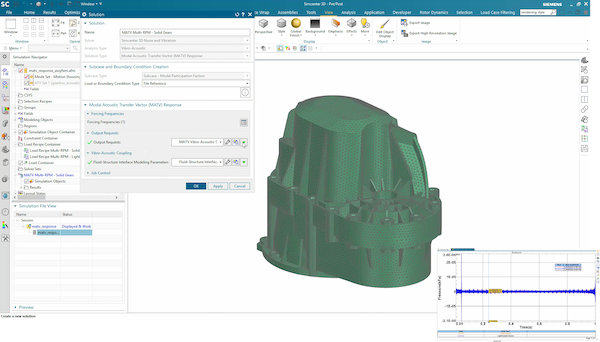Simcenter 3D 2021 Doubles Down on Key Strengths
Latest release focuses on faster CAE processes, multidisciplinary integration, and continued support for an open platform.

New in Simcenter 3D are auralization post-processing capabilities that let engineers listen to simulated pressure results to evaluate sound performance. Image Courtesy of Siemens Digital Industries Software
Latest News
January 31, 2021
With the 2021 release of Simcenter 3D, Siemens Digital Industries Software is fortifying the simulation software with a variety of new capabilities intended to cement its vision for a unified and shared engineering platform.
The latest release introduces artificial intelligence (AI)-based enhancements to the user experience along with new simulation types, enhanced performance, and out-of-box integrations that tie simulation data and processes to the digital thread. Simcenter 3D’s common desktop and UI data model feed all the different physics disciplines, making it easier to perform complex Multiphysics analysis.
New to the 2021 release are new physics modules for auralization and mold design. An auralization post-processing tool lets acoustics engineers and designers actually hear what their design will sound like in addition to visualizing results quantitatively—an advantage because you can’t really see acoustics results. Consider the example of comparing the sounds of two designs for a fast spinning gear—one design that’s solid and the other incorporating holes to reduce mass. “The gears will emit different sounds within the machine, and the auralization tool will allow engineers to actually hear what the sound is for each gear,” explains Pat Farrell, Siemens’ senior marketing manager for Simcenter 3D. “In this way, they can ultimately create the best design that will reduce noise for the end user.”
The new platform advances Siemens’ strategy of democratizing simulation through new thermal analysis capabilities specifically calibrated for mold designers and design engineers. The NX Mold Cooling product employs Simcenter 3D technology to let designers rapidly set up and simulate the thermal performance of injection molds directly in NX as they work on mold design. This facilitates rapid thermal analysis of injection molds without the help of an expert analyst.
“Mold designers are not experts in thermal flow analysis so this gives them a vertical solution tied directly to their workflow,” Farrell says. “It allows them to get information up front without having to ship the work off to someone with deeper knowledge of CFD.”
AI plays a key role in Simcenter 3D 2021 via a new user interface predictive toolbar that continually updates with the next most-likely user command based on understanding how an engineer navigates a simulation workflow. “In that way, they don’t have to go hunting through the menu system to find commands,” Farrell says. “This streamlines the process, making it faster and more efficient.”
On the materials front, Simcenter 3D 2021 takes on challenges related to advanced materials, specifically in the area of cracking. Micro and meso cracking in advanced materials has been difficult to model with the finite element method. To address the problem, Simcenter 3D now includes full representative volume element (RVE) separation and 2D and 3D automatic insertion of cracks or cohesive zones in materials. In addition, macro and microstructural models now allow for full mesh separation for a crack to propagate completely through a material for complete analysis.
For a deep dive into what’s in Simcenter 3D 2021, check out this video.
More Siemens Digital Industries Software Coverage
Subscribe to our FREE magazine, FREE email newsletters or both!
Latest News
About the Author
Beth Stackpole is a contributing editor to Digital Engineering. Send e-mail about this article to [email protected].
Follow DE





